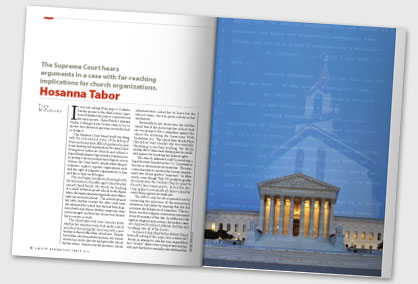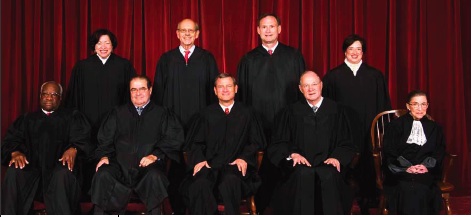Hosanna Tabor
Todd R. McFarland November/December 2011
It was not asking if the pope is Catholic, but the answer to the chief justice's question of whether the pope is a minister had the same answer. Cheryl Perich's attorney Walter Dellinger knew better than to try to answer this rhetorical question, instead he had to dodge it.
The Supreme Court found itself wrestling with the ecclesiastical status of the bishop of Rome and many more difficult questions because it was hearing oral argument in Hosanna-Tabor Evangelical Lutheran Church and School v. Equal Employment Opportunity Commission. In perhaps the most important religion case in 20 years, the Court had to decide where the government's right to regulate employment ends and the right of religious organizations to hire and fire as they see fit begins.
The case began inauspiciously enough with the termination of middle-aged schoolsteacher named Cheryl Perich. Ms. Perich was teaching at a small Lutheran grade school in Michigan when she began experiencing medical problems went out on medical leave. The school replaced her with another teacher but after some time she informed the school that she had been diagnosed with narcolepsy, that her symptoms were now managed, and that her doctor had cleared her to return to work.
The school expressed some concerns about whether her symptoms were truly under control and about disrupting the classroom with a new teacher in the middle of the school year. Despite be told the school needed more time, Ms. Perich showed up on the date she had given the school for her return. Surprised at her presence, school administrators asked her to leave but she refused unless she was given a letter to her satisfaction.
Eventually in her discussions she told the school that if she did not get her old job back she was going to file a complaint against the school for violating the Americans With Disabilities Act. The school then decided that they did not want a teacher who was essentially threatening to sue them teaching. Ms. Perich and the EEOC then sued claiming she was retaliated against for invoking her federal rights.
The church defended itself by invoking a legal doctrine founded in the U.S. Constitution known as the ministerial exception. The ministerial exception says that the various employment laws do not apply to "ministers." In other words, even though Title VII prohibits gender discrimination, the Catholic Church cannot be forced to hire women priests. In fact, this doctrine applies to essentially all claims a minister could bring against an employer.
The EEOC and Perich responded not by contesting the existence of the ministerial exception, but rather by arguing that she did not meet the definition of a minister. The evidence was that religious instruction consumed about 45 minutes of her day. In addition to the explicit religious instruction, the teachers were also supposed to infuse Lutheran doctrine and teachings into all of the classes.
 Justices of the U.S. Supreme Court.
Justices of the U.S. Supreme Court.
So how is it that Chief Justice Roberts found himself asking if the pope was a minister? Perich, in attempt to save her case, argued that her "secular" duties were so important and significant that they essentially overwhelmed her religious duties and therefore she was not a minister. It was not clear how many, if any, of the justices bought this argument.
It would not be accurate to say that this is an easy case for either side. The outside boundaries were more or less agreed on by both sides, but where the line should be drawn was hotly disputed. The government and Perich agreed that the government could not force the Catholic Church to ordain and hire women priests. For Hosanna-Tabor it was important to limit the ministerial exception to employment laws. Hanging over the argument was the specter of this doctrine being expanded to other areas, such as torts, i.e., child sex abuse cases.
This line drawing was the fundamental problem both sides face. The reality is government does have some say in church hiring decisions. In the starkest example for instance recently Catholic bishops have been criminally charged for keeping priests who abused children in pastoral roles. While on its face it seems remarkable that a church leader could be jailed for decisions regarding who serves as a priest, no one wanted to defend the right of the church leader to keep a known abuser in a church.
But the government had its own line drawing problem as well. Many religious entities have policies regarding who can serve as clergy that in the secular world are prohibited. The most well known, of course, is the male-only clergy within the Catholic Church. Just like Hosanna-Tabor did not want to be seen as advocating the right to let child sexual abuse continue, the government did not want to be arguing that it could force the Catholic Church to hire women priests.
When Hosanna-Tabor's lawyer, Douglas Laycock, was asked about the exception extending beyond the employment realm, he was able to draw a bright line—this doctrine applies only in the employment law context. The government did not have such a clear-cut way to limit the government's intrusion. As a result it was forced to rely on two other arguments, namely, that this is a retaliation claim and that this is a school that provides services to the public.
Assistant to the Solicitor General Leondra Kruger argued that while the government's interest in eradicating discrimination was not sufficient to overcome the Catholic Church's right to choose priests based on gender, it had a greater interest in insuring access to the courts. Because this is a retaliation case, Krueger tried to argue that this was about the ability of Ms. Perich to report illegal activity to a governmental agency, the EEOC.
Perhaps realizing this was not the strongest argument, she also argued that the fact that this is a school gives the state more power and less protection to the religious entity. In essence, the government's position is that schools inherently get less protection even when dealing a religion teacher such as Ms. Perich.
This argument was met with considerable skepticism by Justices Scalia and Roberts. They questioned the government about whether this was simply a judgment call about how important the particular belief at issue was to the Lutheran Church. Their concern was that the government decided that the Catholic belief on a male priesthood was older and more important, and deserved more protection than the Lutheran belief of handling disputes internally. The government of course denied making this judgment, but how convincing the argument was remains to be seen.
However, this line of reasoning was warmly received compared to the government's position on where the ministerial exception comes from. For non lawyers it is often enough to call something "unconstitutional" and be satisfied that somewhere in the document the appropriate language exists. Supreme Court justices of course tend to want something more specific.
When pressed to say what part of the Constitution the ministerial exception is based on Ms. Krueger denied that it is found within the either the free exercise or establishment clauses of the First Amendment. Rather, it said it came from the freedom of association right found in the First Amendment.
Justice Scalia described this position as "extraordinary" and Justice Kagan as "amazing." The government's position puts religious entities in the same place as a labor union or a Rotary club. While these entities do enjoy some protection, this reasoning essentially writes out of the U.S. Constitution the free exercise and establishment clauses in employment and substantially weakens the protections for religious entities. The implications of the Obama administration's decision on this issue go far beyond this case.
Regardless of where the ministerial exception can be found in the Constitution, both the government and Perich wanted the Court to adopt a standard that would allow cases to go forward if the court would not have to decide disputed matters of religious doctrine. This is a naive view of how employment cases are litigated. Almost every employment case is a "pretext" case. The employee claims she was terminated because of some protected characteristic; the employer says it was for some legitimate purpose. The courts then decide who is telling the truth.
In the secular context this may be straightforward. But in the religious context almost every aspect of a minister's job is going to touch on a religious issue. Was the pastor meeting the needs of the congregation, were the homilies engaging? It is hard to see a case in which where some religious aspect is not second-guessed.
The fundamental reason this case is so hard is that two rights we hold as a nation are in stark conflict. The uncomfortable truth is that all civil rights legislation presents a conflict of rights. If the government wants to prohibit an employer from discriminating on the basis of race, it is in fact infringing on that private entity's right to spend its money how it sees fit. In effect, one entity loses a right (the employer to hire as it wants), and other group gains a right (the right to not to be discriminated against based on race).
As a nation we long ago made the inherent value judgments with regard to secular employers. No one in mainstream society argues that they should have the right to discriminate any more based on race. That battle is over, and society is better off for all as a result.
But we have not decided where we are on the issue of religion. Government has two strongly competing interests. Religious freedom is a bedrock principal enshrined in our Constitution. But, protecting workers from discrimination is crucial to achieving a more just and equitable society.
What the Court should recognize and what the government and Cheryl Perich failed to realize is that this is a false choice. A robust ministerial exception does not mean a return to 1950s (or 1850s) America. Religious institutions are not the enemies of liberty and justice. They are not seeking to deny the rights of Americans. What they are seeking is the right to worship as they see fit. Will they make mistakes? Yes. There is little question that given the number of religious entities in America that some will not always live up to their ideals.
However, this does not mean the answer is government intrusion. Religious institutions are voluntary organizations. Any church, synagogue, or house of worship that does not live up to its own teachings will eventually find itself in trouble with its own congregants. Having the federal government impose its view on a religious body is simply not the answer. We routinely accept that certain injustices will occur in order to further other goals; this is one of those cases.
Our founders recognized religions special place in society and history. It is not an accident that the first freedom of the U.S. Constitution is religion. A robust ministerial exception benefits all by keeping the government out of religion.